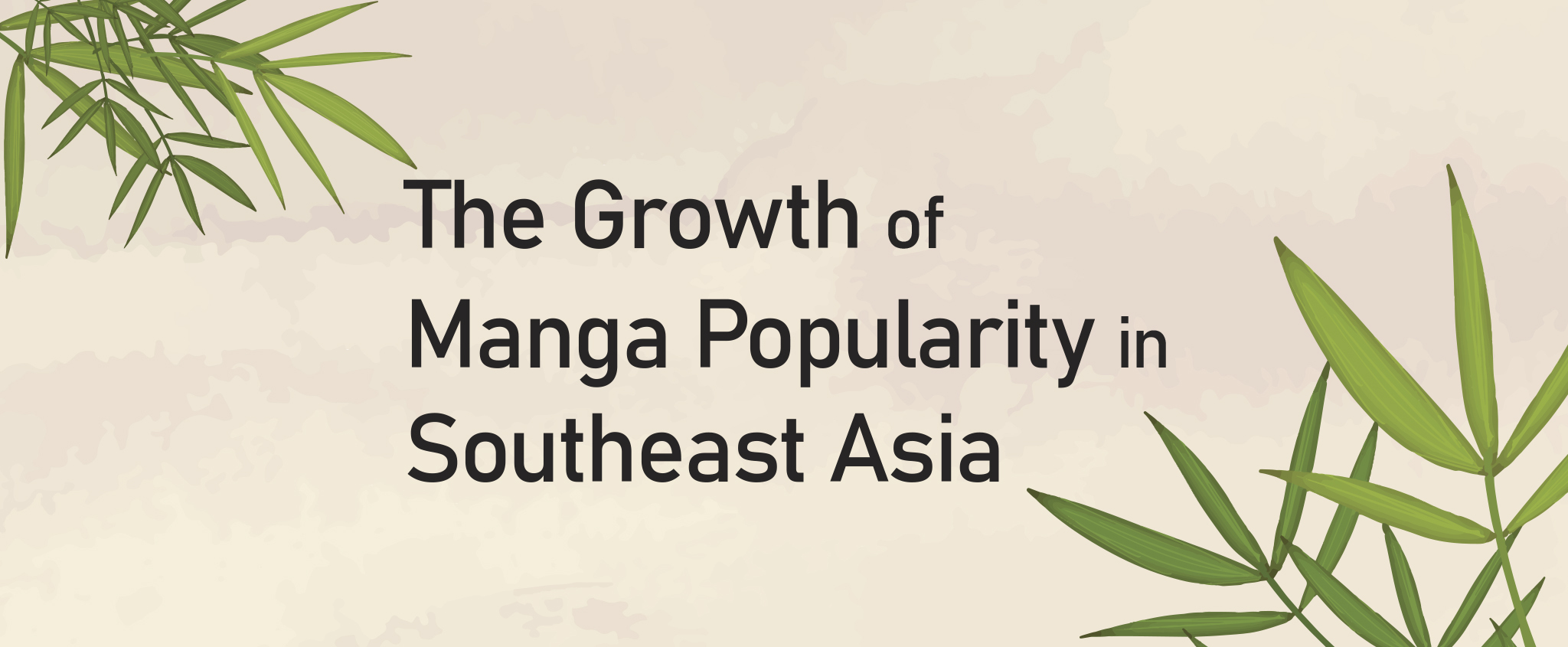What’s driving the growth of Manga Popularity in Southeast Asia
Since the 1970s, Southeast Asia has been receptive of Japanese anime and manga. In 2023, researchers projected substantial progress in the Southeast Asian anime market between 2024 and 2032. By extension, manga popularity in Southeast Asia would grow.
In particular, manga in Thai and Indonesian markets have great potential for anyone eyeing expansion. Publishers looking to expand into established manga readership bases in Southeast Asia can expect many opportunities.
This blog highlights the growth factors for insights into this region being an ideal target market. Take a look.
Key takeaways
- Manga popularity in Southeast Asia is growing primarily because of increased availability and accessibility to audiences.
- Manga in Thai, whether originally in Thai or translated from Japanese, has an established reader base.
- Researchers project manga in Indonesian markets to grow to $138 million in only four years.
Table of contents
- What Factors Are Increasing Manga Popularity in Southeast Asia?
- The Rise of the Manga Industry in Indonesia and Thailand
- How To Support the Growth of Your Manga in Southeast Asia?
What Factors Are Increasing Manga Popularity in Southeast Asia?
Several factors contribute to the increasing manga popularity in Southeast Asia, including:
- Digital accessibility: Southeast Asian fans of Japanese media can discover and enjoy manga much easily now more than ever. With online platforms like Manga Plus and VIZ Media, readers in countries with high internet penetration have convenient manga access. With these websites and apps readily available, fans can read their favorite titles at their leisure. Moreover, these official platforms usually have the appropriate clearances for foreign distribution. Thus, titles usually become available as soon as Japan releases them. As a result, manga’s popularity in the region rises.
- Influence of webtoons: Like manga, webtoons have become popular in Southeast Asia. Their popularity contributes manga’s growing popularity as well. Online platforms like Webtoon and Tapas offer serialized content. This format makes it easily accessible for younger readers. In addition, being free to read online also makes it an ideal entry into the world of visual storytelling. But how do local webtoons influence manga’s popularity? Consider the success of webtoon in Thai and in Bahasa Indonesia. This accomplishment displays a strong appetite for illustrated storytelling in various formats. Accordingly, the trend helps boost overall interest in manga. In addition, creators of webtoon in Bahasa Indonesia and Thai languages likely have manga influences. Consequently, their curious fans may ask these creators about their influences and start getting into manga.
- Cultural affinity: Japan and Southeast Asian countries have historical ties. Therefore, cultural affinity between them is significant in manga’s popularity. Many Southeast Asian readers may find themes portrayed in manga relatable and engaging. Perhaps the storytelling and art styles also reflect similar interests. In addition, Southeast Asian societies have adopted many elements of Japanese pop culture, including anime and manga. With this cultural resonance, the region developed a passionate fanbase that hold various conventions and events celebrating these art forms.
- Local adaptations and translations: Given that most online manga platforms offer titles in English and Spanish, its expanded accessibility still has linguistic limitations. So, local adaptations and translations have made manga more accessible to Southeast Asian audiences. Manga localization service providers like CCCI translate manga into the local languages of Southeast Asian countries. These manga translations bridge language barriers, making it easier for local audiences to enjoy manga in their native languages. For instance, Thai manga translation made the local market grow significantly. Its efforts in localization extend to printing manga in Thai, which makes it more affordable and attractive to local readers. Reading manga in one’s own language enhances the reading experience, making word of mouth a reliable promotional tool.
The Rise of the Manga Industry in Indonesia and Thailand
Manga fans in Indonesia and Thailand rely on professionals like CCCI for manga typesetting services for localized titles. These experts use language and cultural knowledge and skills to bridge Japanese stories to Thai and Indonesian audiences. Here’s a quick look at how manga’s popularity grew in two of the most exciting manga markets in Southeast Asia.
Indonesian Manga Market
Indonesia has one of Southeast Asia’s top manga markets. According to MarketLine research reports, the Indonesian manga market will likely grow to $138 million by 2028. This figure will be 30% more than its profits in 2023.
Moreover, manga in Bahasa Indonesia is only part of the entire printed book market. In 2022, it was worth $800 million, which was $200 million more than the Thai book market. This figure shows how Indonesian audiences appreciate visual storytelling formats, including manga and webtoon in Bahasa Indonesia.
We can trace this established readership to the 1980s, when Elex Publishing released manga in Bahasa Indonesia. What started from popular Japanese titles like Doraemon and Dragon Ball expanded as interest and demand grew. In time, manga in Indonesian opened doors for audiences to explore more formats, particularly webtoons.
Note: Indonesia and Thailand are Southeast Asia’s largest markets for webtoons, based on Naver and Comico numbers. These countries even have local works translated for global audiences.
Thai Manga Market
Similarly, Thai manga is increasingly popular. The accessibility and availability of manga and webtoon in Thai attracts local audiences. Accordingly, traditional printed manga and modern digital webtoons already have readers waiting for new titles.
Historically, comics have already been popular in Thailand since the 1970s. One of the country’s popular titles was Kai Hua Roh (ขายหัวเราะ). This title portrayed slices of life and stayed relevant by reflecting popular culture.
With many manga themes being similar to Thai culture, Thai manga translation brought more options to readers. Manga’s popularity also inspired local writers to emulate its storytelling style. One notable illustrator is Prema Jatukanyaprateep (เปรมา จาตุกัญญาประทีป). In 2013, she won the Gold Award at the 7th International MANGA Award for her comic book Bokbig. This achievement boosts recognition and appreciation of the local graphic storytelling culture.
How To Support the Growth of Your Manga in Southeast Asia?
Capitalizing on manga’s growing popularity in the SEA region requires professional manga and comics services. In particular, localization is a key strategy in appealing to local tastes. With localization, your manga (or even webtoon) would maintain its original nuances while catering to your target audience’s culture. With localization at the core of your strategy for expanding in Southeast Asia, consider the following actions:
- Partner with localization experts: Working with reliable service providers that specialize in Indonesian and Thai languages would be a top priority. These experts know the ins and outs of the local industry and are eager to navigate its intricacies for you. This way, you wouldn’t have to bother with the complexities. After all, as a manga creator or publisher, your schedule must already be fully booked. With a dedicated team handling localization for you, you can focus on the creative aspect of your project. Plus, you can rest assured that you will tap into local fan bases.
- Engage with the local community: Building a strong community around your manga or webtoon can support its growth. Your localization team will ensure it resonates with your target audience. Still, engaging with fans through social media and local events helps create a loyal reader base. This engagement also gives you firsthand access to the preferences and feedback the community has. Consequently, you can apply this knowledge to your future releases.
Pro-tip: Support the local growth of manga and webtoons through official localization channels. Despite the popularity of manga in Southeast Asian markets, piracy remains an issue. Dedicated groups might translate manga to Indonesian from the original Japanese without licenses. While fans would appreciate the access, this method does not support the industry’s growth. Moreover, these fans might not have the professional resources of licensed translators and typesetters.
Given manga’s growth in Southeast Asia, expanding your title to appeal to its local markets is promising. Should you take the next step to translate manga to Indonesian, Thai, Malay, or any Filipino language, work with professionals. At CCCI, we recognize the history and look to the future of manga. Let’s discuss how your next title can fit into the Southeast Asian manga market.






